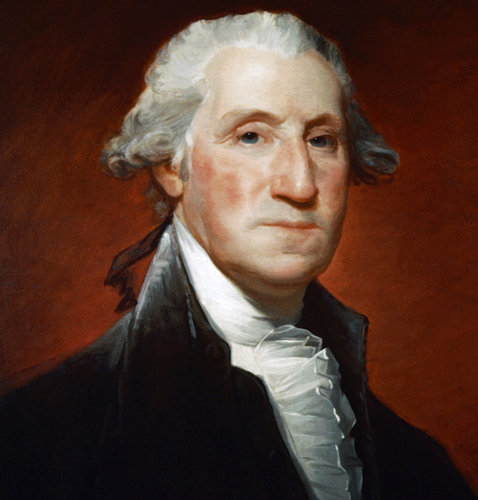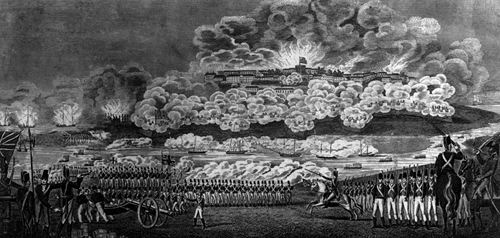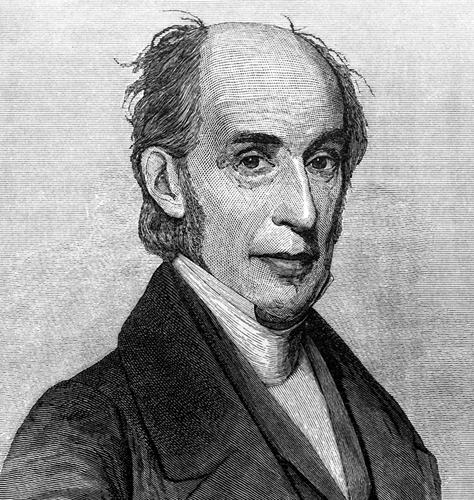Events in the US Capitol’s History
1787
The US Constitution authorizes the establishment of a federal district to be the seat of the American government.
1791
George
Washington selects the site for the new Capitol, with his city planner,
Pierre Charles L’Enfant, on Jenkins Hill, 88 ft (27 m) above the
Potomac River.

George Washington
1792
Dr.
William Thornton wins a design contest for “Congress House,” in which
he proposed a simple central domed hall flanked by two rectangular
wings.
1800
Congress moves from Philadelphia to occupy the north wing of the Capitol.
1810
The Capitol is fully occupied by the House of Representatives and Senate, the Supreme Court, and Library of Congress.
1814
British troops burn the Capitol during the War of 1812.

British burn the Capitol, 1814
1815
Charles
Bulfinch redesigns the fire-damaged building and supervises
reconstruction. The Senate and Supreme Court occupy new rooms by 1819
and the Rotunda is first used in 1824 to host a grand reception for
General Lafayette.

Charles Bulfinch
1851
The
Capitol is again damaged by fire. It is redesigned and rebuilt once
more under the direction of Charles Bulfinch and Thomas U. Walter, who
designs the cast-iron dome. Work is interrupted during the Civil War,
when the Capitol is used as a hospital, barracks, and bakery.
1885–1900
Modern plumbing and electrical lighting are installed for the first time.
1958–1962
The
east front is completely rebuilt, 32 ft (10 m) east of the old
sandstone front. The west front is restored between 1983 and 1987. This
work produces the Capitol we see today.
The Statue of Freedom
Crowning the Capitol
dome stands Thomas Crawford’s Statue of Freedom, and, according to
Capitol police guards, the figure is the most common subject of
visitors’ questions. Why does it face to the east, away from the nation?
Freedom is depicted as a classical female figure, draped in flowing
robes. Her Roman helmet, however, features the crest of an eagle’s head,
feathers, and talons, which some believe to be a reference to Native
American dress. Crawford substituted the Roman helmet for the original
liberty cap, a symbol of freed slaves, when the then US Secretary of
War, Jefferson Davis, objected. The statue faces east in accordance with
the front of the building, not the rest of the country. The east front
was made the main building entrance simply because it faces an approach
of level ground. This monumental symbol of liberty is 19.5 ft (6 m) tall
and weighs around 15,000 lbs (6,800 kg).
The American Ideal
Although the Statue of Freedom may appear to face away from the
heartland, she is, nevertheless, the embodiment of all Americans.
Standing imperiously over the capital, and the nation as a whole, she
encapsulates the notion of freedom for all citizens, laid out in the US
Constitution. It is an ideal still fiercely protected today.

Top 10 Works of Art in the US CapitolStatue of Freedom, Thomas Crawford (Dome)
The Apotheosis of Washington, Constantino Brumidi (Rotunda)
General George Washington Resigning His Commission, John Trumball (Rotunda)
Columbus Doors, Randolph Rogers(East Front)
Minton Tiles (floors and offices)
Brumidi Corridors (Senate Wing)
Statue to Lucretia Mott, Elizabeth Cady Stanton, and Susan B. Anthony, Adelaide Johnson (Rotunda)
Statuary (National Statuary Hall)
Declaration of Independence, John Trumball (Rotunda)
Baptism of Pocahontas, prior to her marriage to John Rolfe, Antonio Cappellano (Rotunda)